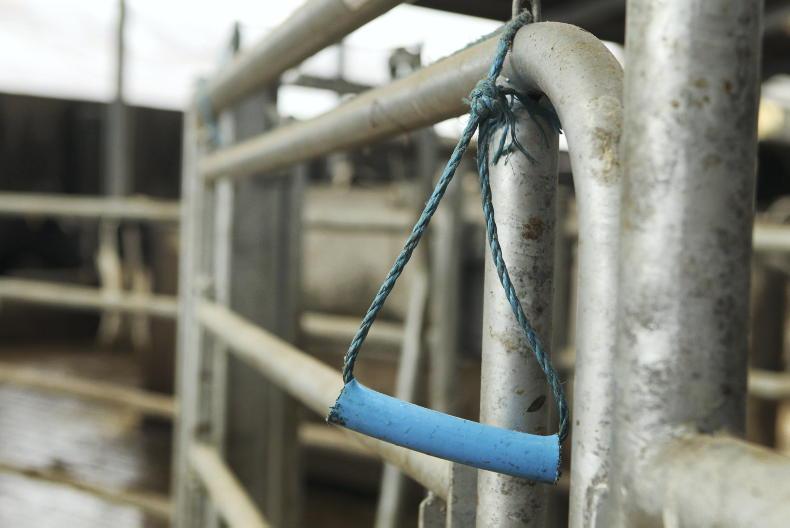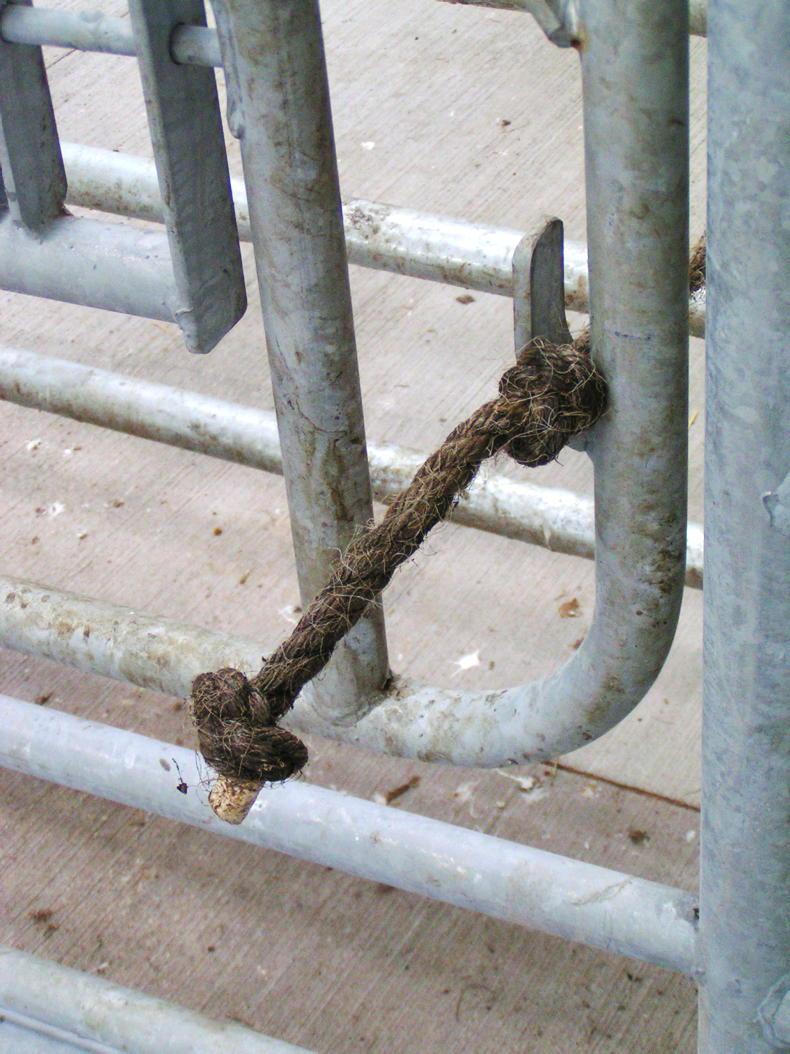When calving a cow, never forget about safety.
Remember that there is only one of you.
Taking a chance or cutting corners can lead to accidents that can have dire consequences for your farm and family.
With spring calving kicking off across Ireland, outlined are five safety tips to remember when assisting a cow during a difficult labour.
1. Always use a proper calving gate
A good calving gate is worth the expense. It will restrain the cow’s head and prevent lateral movement, which is important when using the jack or during surgical intervention.
Position the gate so it closes against the cow’s left flank. The gate should open forwards, and backwards, to release a cow that goes down.
The gate should have two vertical headlock bars, as there is less chance of cow choking if it goes down during calving.

Make sure the headlock can be closed from the rear of the gate. Running a rope to the end of the gate makes this an option.
Do not try to calve cows in the handling race, just because it is the only headlock on farm.
Likewise, do not try to restrain a cow behind a gate in a makeshift calving pen.
It is just not safe and, eventually, a serious accident will occur.
2. Have an escape point in calving pens
When it is necessary to enter a calving pen with an unrestrained animal, make sure you have an alternative exit in case the cow turns on you and cuts off your direct escape route.
Calving pens with sidewalls are less safe than pens with side gates.
Review the safety of the current calving set up and how things can be made safer.
On some farms, this may mean setting up a new calving pen.
3. Securing the calving gate
Make sure the headlock has a rope that runs to the end of the internal side gates.
This makes it easier to engage the locking mechanism from the rear of the animal once the animal moves in to the headlock.

Securing the gate with a rope that can be cut in an emergency is a safer option than a chain.
When the side gate is closed against the animal, securing it with a rope is a safer alternative to a chain.
If the cow goes down, there will be serious pressure on the side gate and the chain will be difficult to release.
However, a rope can be cut in an emergency.
4. Stay on the left of the calving jack
Only one operator should be in control of the calving jack.
When the jack is attached to the cow, never stand between the bar of the jack and the side wall or side gate.
If a cow goes down quickly, the operator can easily be injured by the bar of the jack.
If the calving gate closes against the left side of the cow, then always operate the jack by standing on the left side of the ratchet bar.
5. Tagging calves and treating navals
Once the calf is born, the cow’s protective instinct will kick in. This is when the cow is at its most dangerous.
On the occasions you have to enter a pen to treat a calf’s naval, help it suckle or to tag the animal, always do so in a slow, calm manner.
Before entering the pen, try to restrain the cow in the headlock by offering some concentrate first.
If the cow doesn’t come forward, leave her be. Don’t stress or raise the cow’s temperament.
If the pen does not have a headlock and there is no alternative option for restraining the animal, never get between the cow and her calf.
Never turn your back on the cow and always face the cow when working a calf.
Read more
Beef management: 10 tips when using the calving jack
Save the date: Irish Farmers Journal spring webinar series
When calving a cow, never forget about safety.
Remember that there is only one of you.
Taking a chance or cutting corners can lead to accidents that can have dire consequences for your farm and family.
With spring calving kicking off across Ireland, outlined are five safety tips to remember when assisting a cow during a difficult labour.
1. Always use a proper calving gate
A good calving gate is worth the expense. It will restrain the cow’s head and prevent lateral movement, which is important when using the jack or during surgical intervention.
Position the gate so it closes against the cow’s left flank. The gate should open forwards, and backwards, to release a cow that goes down.
The gate should have two vertical headlock bars, as there is less chance of cow choking if it goes down during calving.

Make sure the headlock can be closed from the rear of the gate. Running a rope to the end of the gate makes this an option.
Do not try to calve cows in the handling race, just because it is the only headlock on farm.
Likewise, do not try to restrain a cow behind a gate in a makeshift calving pen.
It is just not safe and, eventually, a serious accident will occur.
2. Have an escape point in calving pens
When it is necessary to enter a calving pen with an unrestrained animal, make sure you have an alternative exit in case the cow turns on you and cuts off your direct escape route.
Calving pens with sidewalls are less safe than pens with side gates.
Review the safety of the current calving set up and how things can be made safer.
On some farms, this may mean setting up a new calving pen.
3. Securing the calving gate
Make sure the headlock has a rope that runs to the end of the internal side gates.
This makes it easier to engage the locking mechanism from the rear of the animal once the animal moves in to the headlock.

Securing the gate with a rope that can be cut in an emergency is a safer option than a chain.
When the side gate is closed against the animal, securing it with a rope is a safer alternative to a chain.
If the cow goes down, there will be serious pressure on the side gate and the chain will be difficult to release.
However, a rope can be cut in an emergency.
4. Stay on the left of the calving jack
Only one operator should be in control of the calving jack.
When the jack is attached to the cow, never stand between the bar of the jack and the side wall or side gate.
If a cow goes down quickly, the operator can easily be injured by the bar of the jack.
If the calving gate closes against the left side of the cow, then always operate the jack by standing on the left side of the ratchet bar.
5. Tagging calves and treating navals
Once the calf is born, the cow’s protective instinct will kick in. This is when the cow is at its most dangerous.
On the occasions you have to enter a pen to treat a calf’s naval, help it suckle or to tag the animal, always do so in a slow, calm manner.
Before entering the pen, try to restrain the cow in the headlock by offering some concentrate first.
If the cow doesn’t come forward, leave her be. Don’t stress or raise the cow’s temperament.
If the pen does not have a headlock and there is no alternative option for restraining the animal, never get between the cow and her calf.
Never turn your back on the cow and always face the cow when working a calf.
Read more
Beef management: 10 tips when using the calving jack
Save the date: Irish Farmers Journal spring webinar series








 This is a subscriber-only article
This is a subscriber-only article









SHARING OPTIONS: